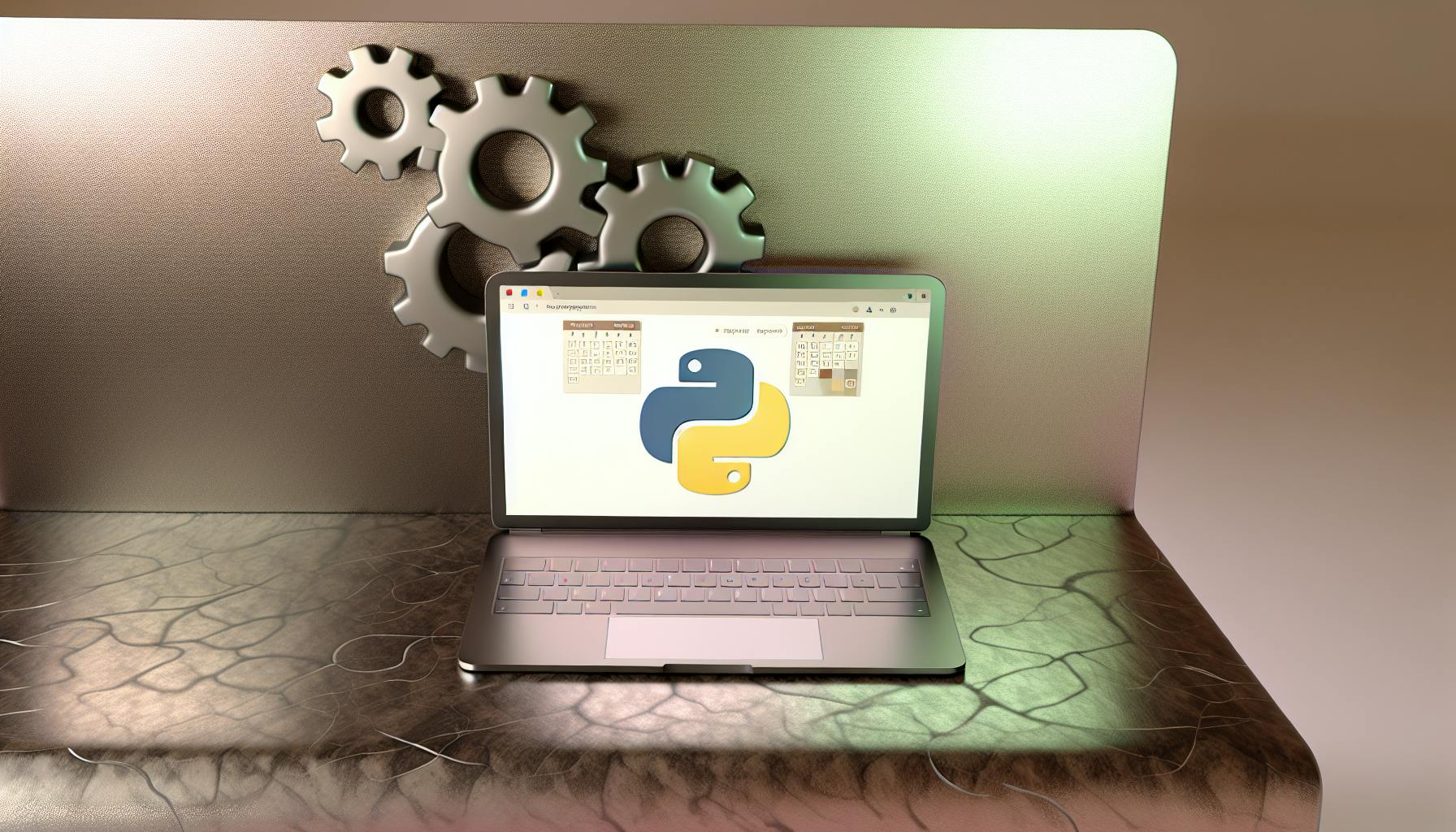Performing statistical modeling can be challenging without the right tools.
Luckily, Python offers a robust set of libraries and packages that make statistical analysis and modeling straightforward.
In this post, you'll learn step-by-step how to leverage Python for a variety of statistical modeling techniques, from linear regression to neural networks. We'll cover essential packages like Pandas, NumPy, StatsModels, Scikit-Learn, and more.
Introduction to Statistical Modeling with Python
Python is rapidly becoming the programming language of choice for statistical analysis and data science due to its flexibility, wide range of statistical and data analysis packages, and ease of use. This step-by-step tutorial will provide a hands-on introduction to using Python for statistical modeling and data analysis.
We will cover the key concepts and steps involved in:
- Importing, cleaning, and preparing data for analysis
- Exploratory data analysis techniques
- Statistical modeling and predictive analysis with packages like Statsmodels, Scikit-learn and Pandas
- Model evaluation metrics and techniques
- Visualizing and interpreting results
By the end of this tutorial, you will have a solid foundation to start building statistical models in Python to derive actionable insights from data.
What is statistical Modelling in Python?
Statistical modeling refers to the process of applying statistical analysis techniques to examine and draw insights from data. Python has become one of the most popular programming languages for statistical modeling due to its flexibility, scalability, and vast ecosystem of data science libraries.
Some key aspects of using Python for statistical modeling include:
- Access to statistical and data analysis packages - Python has many robust libraries like Pandas, Statsmodels, Scikit-learn, PyTorch, and TensorFlow for different types of statistical analysis and modeling tasks. These provide pre-built functions and classes to quickly get started.
- Exploratory data analysis (EDA) - Python makes it easy to load, manipulate and visualize data to uncover patterns, anomalies, relationships and gain insights. Packages like Pandas, Matplotlib and Seaborn are extremely useful here.
- Model building and validation - Python enables building predictive models like linear regression, logistic regression, random forests, neural networks etc. using libraries like Statsmodels, Scikit-learn and Keras. Techniques like train-test splits and cross-validation help validate model performance.
- Scalability - Python seamlessly integrates with big data technologies like Spark for large-scale statistical modeling and data analysis. This makes it applicable for small and big data projects.
In summary, Python is a versatile, scalable and powerful programming language for applying statistical models to understand data and make data-driven predictions and decisions in fields like finance, healthcare, science and more. The vast ecosystem of Python data science libraries provides accessible building blocks to efficiently develop robust statistical models.
What are the statistical modeling tools in Python?
Python has a robust ecosystem of libraries and packages for statistical modeling and data analysis. Some of the most popular and widely-used ones are:
statsmodels
statsmodels is a powerful Python module that enables users to explore data, estimate statistical models, and perform statistical tests. Some key features of statsmodels for statistical modeling include:
- Linear regression models
- Generalized linear models with support for logistic and Poisson regression
- Time series analysis tools like ARIMA and GARCH models
- Extensive suite of statistical tests
- Tools for descriptive statistics and data visualization
- Imputation of missing data
- Extensive output statistics like p-values, R-squared, residuals etc.
Statsmodels allows rapid prototyping of statistical models like linear models, GLM, and classical econometric models. It has an intuitive formula API that makes it easy to fit models. Statsmodels also integrates well with pandas and NumPy data structures.
Scikit-Learn
Scikit-Learn provides Python modules for machine learning and statistical modeling like regression, classification, clustering, dimensionality reduction, and model selection. Some of its tools include:
- Regression models - linear regression, logistic regression etc.
- SVM for classification and regression tasks
- Naive Bayes classifier
- KNN classifier
- Decision trees and random forests
- Ensemble methods like Bagging, Boosting, Stacking etc.
- Tools for model validation, evaluation, calibration etc.
Scikit-Learn features a consistent API across all its statistical and machine learning tools, which makes it easy to switch between models. It also plays well with NumPy, SciPy and pandas data structures.
Keras
Keras is a high-level API focused on enabling fast experimentation with deep neural networks. It runs on top of TensorFlow and supports convolutional and recurrent neural networks. Keras makes it easy to quickly prototype and evaluate deep learning models.
Some additional Python libraries used for statistical modeling include: PyMC3, TensorFlow Probability, Pyro, Prophet, Lifelines, GluonTS. The Python ecosystem offers a diverse set of tools for different statistical modeling and machine learning tasks.
How to do modelling in Python?
To do statistical modeling in Python, follow these key steps:
Step 1: Install Required Libraries
First, install essential Python libraries like NumPy, Pandas, Statsmodels, Scikit-learn, etc. These provide tools for data manipulation, analysis and modeling. Some popular options:
numpy- numerical Python for matrices, arrays, math functionspandas- data structures and analysis toolsscipy- algorithms and statistical modelingstatsmodels- statistical models like regression, ANOVAscikit-learn- machine learning algorithmsmatplotlib- data visualization and plotting
Install them using pip or conda.
Step 2: Load the Dataset
Import your dataset into a Pandas dataframe for easier data manipulation and analysis. Clean the data, handle missing values, encode categorical variables, etc.
import pandas as pd
df = pd.read_csv("dataset.csv")
Step 3: Explore and Preprocess Data
Before modeling, explore the data distribution using plots, statistical summaries, etc. Check for outliers, missing data, collinearity between predictors. Address these by transforming variables, imputing missing values, removing outliers etc.
df.describe()
df.isnull().sum()
Step 4: Train Statistical Models
Using the preprocessed data, train and fit models from statsmodels and scikit-learn to uncover patterns. Examples include linear regression, logistic regression, ANOVA, ensembles like random forest, SVM and more.
from sklearn.linear_model import LinearRegression
model = LinearRegression()
model.fit(X_train, y_train)
Step 5: Evaluate Model Performance
Evaluate models on a test set using appropriate metrics like R-squared, RMSE, accuracy score etc. Choose the best performing model for your problem.
print(model.score(X_test, y_test))
Following these key steps provides a structured framework to leverage Python for statistical data analysis and modeling.
Can I use Python for statistical analysis?
Python is considered one of the best programming languages for statistical analysis and data science due to its flexibility, ease of use, and extensive ecosystem of data analysis libraries.
Here are some of the key reasons why Python excels at statistical analysis:
- Simple and Flexible Syntax: Python has a simple, easy-to-read syntax that is great for manipulating, analyzing, and visualizing data. Its flexibility allows you to write code quickly and concisely.
- Powerful Ecosystem of Libraries: Python has an enormous collection of specialized libraries like NumPy, Pandas, SciPy, StatsModels, Scikit-Learn, Matplotlib, and Seaborn purpose-built for data analysis, statistics, machine learning, and data visualization.
- Integration with Other Languages: Python integrates well with other languages like R, SQL, C/C++, Java allowing you to leverage multiple tools.
- Available Computing Power: Python can leverage multi-core processors and GPUs to scale statistical analysis and machine learning pipelines to very large datasets.
- Open Source: As an open source language with an active developer community, new Python data analysis libraries are constantly emerging and improving.
In summary, Python provides a scalable, flexible, and open environment ideal for statistical analysis - from simple summary stats to advanced predictive modeling. The multitude of specialized libraries enable rich statistical capabilities accessible to coders at any level. These capabilities continue to grow through ongoing open-source development making Python a solid long-term choice for data analysis.
sbb-itb-ceaa4ed
Python Packages for Statistical Analysis and Modeling
Python has a robust ecosystem of open-source libraries for statistical analysis, machine learning, and data science. Some of the most popular packages used for statistical modeling and data analysis tasks are:
Pandas for Data Manipulation and Analysis
Pandas provides fast, flexible, and expressive data structures designed to make working with relational and labeled data both easy and intuitive. Key features include:
- Data loading and manipulation tools for CSV, Excel, SQL databases, and other sources
- Integrated indexing for convenient data alignment, slicing, subsetting, and filtering
- Tools for missing data handling, data wrangling, grouping, aggregating, pivoting, etc.
- High performance merging, joining, and time series functionality
- Built-in visualization and statistical analysis methods for EDA
For statistical modeling and analysis workflows, Pandas excels at data preparation and manipulation prior to model building.
NumPy for Matrix Algebra and Numeric Data
NumPy offers optimized arrays and matrix data structures for efficient numeric computing. For statistical analysis, NumPy provides:
- N-dimensional array objects for vector, matrix, and tensor manipulation
- Broadcasting functions for element-wise array operations
- Linear algebra, Fourier transforms, random number generation, and more
- Interoperability with hardware acceleration libraries like Numba
NumPy arrays integrate tightly with Pandas for numeric data wrangling. The combination enables fast vectorized statistical computations.
StatsModels for Econometric and Statistical Modeling
StatsModels specializes in classical and Bayesian statistical modeling, hypothesis testing, and econometric analyses:
- Linear regression models, ANOVA, generalized linear models, time series analysis
- Parametric and nonparametric statistical tests
- Result statistics like p-values, confidence intervals, prediction/forecasting
- Model specification, estimation, validation, prediction, and inference tools
For statistical modeling workflows, StatsModels provides the underlying statistical machinery for estimating models and generating key statistics.
Scikit-Learn for Machine Learning
Scikit-Learn offers a vast library of machine learning algorithms for predictive modeling, classification, regression, clustering, dimensionality reduction, model selection, and more:
- Consistent API and pipeline tools for building ML workflows
- Implementation of supervised and unsupervised learning techniques
- Model evaluation metrics, cross-validation strategies, hyperparameter tuning
- Interoperability with NumPy, SciPy, Pandas, StatsModels, Matplotlib
For statistical analysis, Scikit-Learn delivers production-ready ML models like regression, forecasting algorithms, and dimensionality reduction techniques.
Seaborn for Advanced Data Visualization
Seaborn is a statistical data visualization library built on Matplotlib. It provides beautiful default styles and color palettes for visualizing statistical relationships in data:
- Specialized statistical plot types like histograms, scatterplots, regression plots, clustering plots, etc.
- Tools to visualize linear regression models, statistical distributions, matrices of data
- Control over plot aesthetics, color palettes, plot scales, annotations
- Tight integration with Pandas DataFrames and NumPy arrays
Seaborn makes exploring data visually through statistical graphs an integral part of the analysis process.
Together, these Python packages provide a complete, integrated toolset for statistical analysis, modeling, machine learning, and data visualization workflows. From data manipulation, to model building, evaluation, and visualization - Python has an exceptional ecosystem for statistics and data science.
Exploratory Data Analysis (EDA) with Python
Exploratory data analysis (EDA) is a critical first step when working with any dataset. Python provides many useful tools and libraries for efficiently performing key EDA tasks like handling missing values, detecting outliers, feature engineering, and statistical analysis.
Inspecting and Encoding Missing Data
Dealing with missing data is inevitable when working with real-world datasets. Python's Pandas library makes it straightforward to identify, count, visualize and ultimately fill in or remove missing values. Here is a simple example using .isnull() and .dropna():
import pandas as pd
df = pd.DataFrame({"A": [1, np.nan, 3], "B": [5, 2, np.nan]})
print(df.isnull())
print(df.dropna())
For imputing missing numeric data, Scikit-Learn provides the SimpleImputer class to fill gaps with mean, median or most frequent values.
Outlier Detection and Treatment
Outliers can skew results and need special treatment. Python's Scikit-Learn has two great outlier detection classes - LocalOutlierFactor (unsupervised) and IsolationForest (supervised). Simple ways to handle outliers include clipping, filtering or imputation methods.
Descriptive Statistics and Data Visualization
Understanding feature distributions is critical for EDA. Python's NumPy, Pandas and Seaborn provide methods to easily calculate and visualize descriptive stats.
import seaborn as sns
sns.distplot(df["column_name"])
print(df.describe())
Histograms, box plots and density plots quickly highlight outliers and skewed data.
Bivariate Analysis Using Correlation and P-value
Examining relationships between features is key. Pandas and SciPy have built-in methods to calculate correlation coefficients like Pearson, Spearman and Kendall Tau. Statsmodels enables statistical tests for correlation significance.
import pandas as pd
from scipy import stats
import statsmodels.api as sm
print(df.corr())
sm.stats.pearsonr(x, y)
Python makes EDA efficient and insightful. With its versatility and power, these critical pre-modeling steps become straightforward.
Statistical Modeling Techniques in Python
Statistical modeling is a crucial skill for data scientists and analysts to make predictions and gain insights from data. Python offers a versatile set of tools and techniques to build statistical models for a variety of applications.
Implementing Linear Regression Models
Linear regression is used to model the relationship between a dependent variable and one or more independent variables. Key steps include:
- Checking assumptions - linearity, normality, homoscedasticity, independence
- Feature engineering and selection
- Fitting a simple linear model with
statsmodelsorscikit-learn - Interpreting model coefficients and summary statistics like p-values, R-squared
- Building multiple linear regression models with multiple features
Logistic Regression for Predictive Modeling
Logistic regression predicts categorical outcomes based on predictor variables. When implementing:
- Encode categorical variables
- Balance the dataset
- Fit logistic regression model in Python
- Interpret odds ratios and coefficient estimates
- Evaluate classification accuracy, AUC-ROC curve
Multinomial logistic regression handles outcomes with more than two categories.
Model Evaluation and Resampling Techniques
To assess model generalizability:
- Split data into train and test sets
- Use K-Fold cross validation
- Evaluate precision, recall, F1 score
- Analyze confusion matrix
Resampling methods like bootstrapping provide confidence intervals for model estimates.
Advanced Statistical Methods: Neural Networks and Econometric Modeling
Beyond linear models, Python enables more advanced techniques:
- Neural networks model complex nonlinear relationships
- Time series analysis with econometric models like ARIMA
- Ensemble models combine multiple statistical models
Overall, Python provides a flexible toolkit to build and evaluate a wide range of statistical models for data analysis.
Exporting and Deploying Statistical Models
Exporting Models with Pickle and Joblib
Python provides useful libraries like Pickle and Joblib to serialize trained statistical models, allowing you to save models for future use without having to retrain them.
To export a model with Pickle:
- Import
pickle - Train your statistical model (e.g. linear regression)
- Open a file for writing bytes
- Use
pickle.dump()to serialize your model and write it to the file
For example:
import pickle
from sklearn.linear_model import LinearRegression
# Train model
model = LinearRegression()
model.fit(X_train, y_train)
# Export model
with open('model.pkl', 'wb') as f:
pickle.dump(model, f)
To load and use an exported Pickle model:
- Import
pickle - Open the Pickle file for reading bytes
- Use
pickle.load()to deserialize the model - Make predictions with the loaded model
Joblib works similarly but adds optimizations for scientific Python data like NumPy arrays and Pandas DataFrames.
Introduction to Model Deployment with Flask
Flask provides a simple web framework for deploying Python models. Key steps include:
- Serialize the model with Pickle or Joblib
- Write a Flask app to load the model and handle requests
- Add prediction logic to process user input and return predictions
- Configure and launch the Flask web server
For example:
import pickle
from flask import Flask
app = Flask(__name__)
with open('model.pkl', 'rb') as f:
model = pickle.load(f)
@app.route('/predict', methods=['POST'])
def predict():
# Extract user input
user_data = request.get_json()
X_new = [...] # process input
# Make prediction
y_pred = model.predict([X_new])
# Return JSON response
return jsonify({'prediction': y_pred[0]})
if __name__ == "__main__":
app.run(debug=True)
This loads the exported model, handles /predict requests, runs the model on input data, and returns the prediction in a JSON response.
Deploying Machine Learning Models with Amazon SageMaker
Amazon SageMaker simplifies deploying models at scale:
- Upload training code and data to S3 buckets
- Define model parameters like instance types and endpoints
- Launch training jobs to fit models using SageMaker's managed infrastructure
- Deploy trained models to hosted endpoints
- Invoke real-time predictions from client apps
SageMaker handles instance provisioning, model serialization, request routing, autoscaling etc. allowing you to focus on training and inference code. SageMaker endpoints can be invoked from AWS Lambda functions, mobile apps, or HTTP requests.
Final Thoughts and Next Steps in Statistical Modeling with Python
Python provides a versatile platform for statistical modeling and data analysis. By following the step-by-step process outlined in this article, you can leverage Python's extensive libraries and tools to build predictive models and draw data-driven insights.
Here are some key takeaways:
- With packages like Pandas, NumPy, SciPy, and StatsModels, Python has rich support for statistical modeling and data analysis tasks
- Carefully inspecting and preparing your data is crucial before fitting models
- Linear regression and logistic regression are fundamental statistical modeling techniques with Python to understand
- Model validation through training/testing data splits helps gauge real-world performance
- Visualizations with Matplotlib and Seaborn provide deeper insight into models and data
Looking ahead, consider exploring more advanced Python ML techniques like random forests, gradient boosting machines, and neural networks. Tuning hyperparameters and comparing evaluation metrics can further optimize models.
As always, focus on developing business intuition and aligning modeling objectives with practical goals. Statistical models are means to an end - better data-driven decisions. By mastering Python's modeling tools, you'll be well-equipped to keep pushing the boundaries of what's possible.


